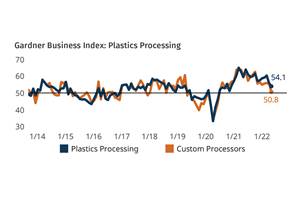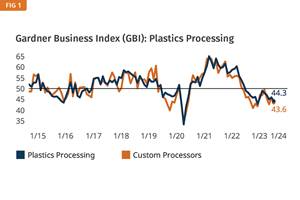Computers & Electronics Holding Steady
Wood on Plastics
Forecast calls for a rise in domestic production of 5% this year compared with total output in 2011.
After three consecutive years of declining production, the total output of the computers and electronics industry in the U.S. is expected to register a moderate increase in 2012. Our latest forecast calls for a rise in domestic production of 5% this year compared with total output in 2011. Downside risks to this forecast include greater than expected shocks to global markets resulting from the European financial crisis; failure by Congress to avoid the fiscal crisis that looms at the end of this year; and further deterioration of the foreclosure crisis in the residential housing sector.
But assuming there are no surprises, the economic fundamentals that drive consumer spending will start to improve gradually in the second half of 2012 and throughout 2013. The U.S. economic recovery hit a soft patch in the spring of this year, but we should be well beyond these doldrums by the end of this summer.
The rapid pace of technological innovation will keep market demand for computers and electronics strong for the foreseeable future. But the most important question for this sector is not whether there will be market growth, but rather, where will these products be manufactured?
As the accompanying chart illustrates, total output of the U.S. computer sector has been bumping along at its cyclical bottom for the past year and a half. From its pre-recession peak, total production fell by 38% over the next two years through 2010, and it has been treading water ever since. The real disappointment in this lackluster recovery is that overall consumption of computers and electronics products has expanded quite briskly during the past three years, both in the U.S. and globally. So the market is expanding, but American companies are not reaping the benefits of this growth.
There is anecdotal evidence to suggest that more of the manufacturing for this sector will be located here in the U.S. The CEO of Apple has publicly stated that he would like to manufacture more products here, and there is a company making large-screen TVs in America that reports strong demand for its products. The U.S. is by far the world’s largest per capita consumer of electronics. And most of these products, along with the software that runs them, are designed here as well. In the long run, it only makes sense that much of the hardware would be manufactured here as well. This will be the trend of the future, but it will take more time for the trend to really get going. Thus, the forecast is for moderate growth in 2012, and somewhat stronger gains in 2013.
Smartphones and tablets are the products that are currently driving growth in this sector, and these products will remain the dominant force for the next few quarters, at least. The trends of ever-increasing access to small-sized computing power combined with greater bandwidth mean that people are living more of their lives connected to their mobile devices. And this is no longer limited to just those who have developed sufficient thumb dexterity. So there is plenty of room for growth remaining.
Other electronics products such as televisions, personal computers, and smart appliances will also enjoy growing market demand in the coming years, but the gains in these sectors will be a bit more dependent on the trends in employment, household incomes, and residential real estate. These macroeconomic trends will struggle to gain momentum during the next quarter or two, but they are expected to establish a sustained uptrend next year, assuming the policymakers in Washington don’t make a huge mistake at the end of this year.
WHAT THIS MEANS TO YOU
•3G? 4G? 5G? There are huge bets being made on how to raise the speed that data can be transmitted. This will have a major impact on future demand for devices and the supporting infrastructure.
•Accessory items such as protective shells and carrying cases are also rapidly growing sectors of the mobile device market.
•The wireless communications sector is composed of many components that actually use a lot of wire (towers, servers, and the cables and connectors between them). Demand for these products is also growing.
Related Content
Processing Slips as Summer Simmers
Monthly index suggests slower growth in June for plastics processors overall and contraction for custom firms.
Read MoreProcessing Megatrends Drive New Product Developments at NPE2024
It’s all about sustainability and the circular economy, and it will be on display in Orlando across all the major processes. But there will be plenty to see in automation, AI and machine learning as well.
Read MorePlastics Processing Growth Slows Slightly
May reading for plastics processors is, for the most part, a continuation of what we saw in April.
Read MorePlastics Processing Business Index Contracts Further
All components dip as index hits low point of 2023.
Read MoreRead Next
How Polymer Melts in Single-Screw Extruders
Understanding how polymer melts in a single-screw extruder could help you optimize your screw design to eliminate defect-causing solid polymer fragments.
Read MoreUnderstanding Melting in Single-Screw Extruders
You can better visualize the melting process by “flipping” the observation point so that the barrel appears to be turning clockwise around a stationary screw.
Read MoreProcessor Turns to AI to Help Keep Machines Humming
At captive processor McConkey, a new generation of artificial intelligence models, highlighted by ChatGPT, is helping it wade through the shortage of skilled labor and keep its production lines churning out good parts.
Read More













.png;maxWidth=300;quality=90)








